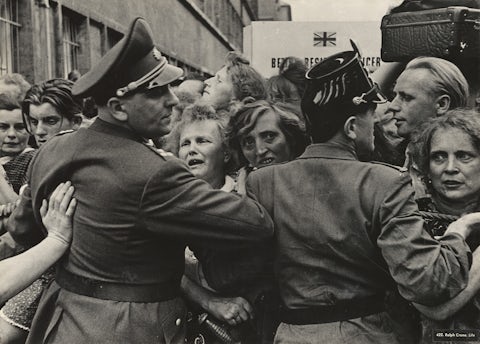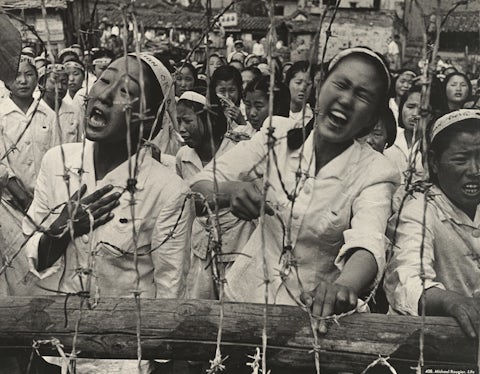In the context of the 1950s: A world on the brink
Beginning of the 50s. The world had been bled dry and was struggling to recover from one of the greatest tragedies of its history: The Second World War.
After the horror of the concentration camps the world had to face a period of uncertainty, loss of landmarks and fear mainly due to the bipolarisation of the two blocs of East and West. Indeed, among the victors of the war, the United States and the former Soviet Union (USSR) emerged as two superpowers. After 1947 the tension was palpable between both countries supported by their respective allies and the world was to sink slowly into the “Cold War”. The world was divided between the USA and the USSR, reflected by the construction of the Berlin Wall which cut off Germany into two states.

Anonymous, Jews arrested during the destruction of the Warsaw ghetto in Poland by the SS, sent to be gassed at Treblinka extermination camp, Warsaw Ghetto, Germany, May 1943

Anonymous, Two young men throw paving stones at a Soviet tank in Leipziger Straße in East Berlin in an unequal fight, Berlin, Germany, 17/06/1953 © PICTURE ALLIANCE / AKG-IMAGES

Ralph Crane, West Berlin Police holding back crowds who are coming from East Berlin for food and clothing, Germany, 1953, Time & Life © Getty Images
Without any direct confrontation both powers kept on defying and provoking one another, notably concerning the atomic bomb. Fully aware of their military and deterrent power, they began a nuclear arms race, while seeking to acquire the most powerful weapon. In 1949, they both got it. The threat of a new generalised conflict, even more violent and destructive than what man had ever known was thus hanging over the whole world.
Even if the time had come for reconstruction, baby-boom and the “Glorious Thirty”, joyous and carefree days would take more time to show up. In response to this pernicious climate, the western youth and adolescence, as a specific age group between childhood and adulthood, structured themselves: schooling was extended, the US influence brought jeans and new musical styles like rock’n’roll.

Lou Bernstein, USA, 1949

Ralph Crane, Young couple cuddling as they sit down in a hole in the sand while others lie around behind them on a hot Independence Day at the beach, Santa Monica, California, USA, 1950, Time & Life © Getty Images
Consumptive lifestyle developed quickly and young generations turned against authority whether from parents or governments, accusing them for being responsible for this shift of the world into horror. As a sign of revolt, some stood up against segregation, specifically in the USA, others denounced injustices, refused inequalities or called for pacifism. More than their elders who were keeping in mind the memory of war, young people became the embodiment of the famous “Never again”.
The golden age of photojournalism and illustrated magazines
To respond to this crisis about the identity of man and their place into the world, intrinsically tied to an unprecedented historical context, photojournalism affirmed its position as the privileged means to show the world as it was, to report back on its status, to point out its ongoing movements. This form of reports had its origins at the end of the 19th century and was tied to a strong willingness to cover war events as close to the battlefields as possible.

Michael Rougier, South Korean youths demonstrating against truce, 1953, South Korea, Time & Life © Getty Images

David Duncan, Portrait of Captain Ike Fenton, U.S. Marine, during the Korean war, Naktong River Perimeter, Korea, 1950, Harry Ransom Center The University of Texas at Austin
The first photo reports
In 1856 photography as war reporting appeared in the press with the pictures about the Crimean War made by the first English war photographer Roger Fenton. The French photo reporter François Aubert produced a series of photographs on the Mexican War and the American Mathew Brady took about 8,000 shots of the Secession War in the USA. By the way, it is one of his images that has been selected to be a part of The Family of Man and it is therefore the oldest image of the whole exhibition. At that time the material was heavy, the cameras weighed nearly 40 kilos and were not made to be carried throughout conflict zones or to follow the armies. The exposure time to get a sharp picture was from 5 to 10 minutes, which hindered the photographers in their willingness to capture instant or moving images. And this is the reason why, due to the size and cumbersome nature of that equipment, it was not until the inter-war period that the use of photography became widespread in the media. Its development was notably related to the launch of the Leica camera during the 1920s. It was a compact and portable device, weighing only 377 grams and it made it thus possible to take pictures as close to the action as possible.

Mathew Brady, Confederate Soldier of Ewell's corps killed in the attack of May 19 (civil war), USA, 1864
In the inter-war period, the technical advances in the fields of press and photography progressively enabled photos to be replicated and published with a large circulation, thus promoting the development of photojournalism. Orders for reports began to increase in order to meet the expectations of a public, who wanted to “view” and feel as though they were at the heart of the action. With that in mind, new illustrated magazines emerged that gave pride of place to images of the great world events: Regards, Vu, LIFE, Picture Post, Fortune or Paris-Match.
LIFE magazine
In 1936 LIFE became an iconic weekly magazine, focused on photojournalism and it played a significant role during the 20th century. Indeed, with references to any subjects from burning issues to art, the magazine made clear its ambition to be a place where images would always be a testimony of life, the world and its events. And it was a real revolution for journalism. This is how it used to work with the greatest photographers of that time such as Alfred Eisenstaedt, Margaret Bourke-White, Robert Capa, Andreas Feininger, Lee Miller, Nina Leen, Burk Uzzle… most of them being part of The Family of Man.
Reporters were sent onsite. The pictures they took brought their names to legendary status: Robert Capa, Gerda Taro, Henri Cartier-Bresson, David Seymour…
The Magnum Photos agency
The photo reporters would organise themselves in photographic press agencies. In 1947, four pioneering photographers founded the now legendary Magnum Photos agency. Robert Capa, Henri Cartier-Bresson, George Rodger and David Seymour owned the most important cooperative ever created. This way of working guaranteed full independence to its members, enabled a large freedom in the choice and processing of photos and ensured exclusive copyrights over their creation. All of them believed in the power of image to tell the world, to witness its continuity and its transformation and to initiate an awareness which was an essential part in the smooth running of society.
The photojournalism that has developed was based on two main issues: the willingness to cover facts while keeping one’s objectivity was closely tied to the need for photo reporters to illustrate their own vision of man. All of them used to work or had been working for the press at a time when television had not yet invaded homes and illustrated magazines were the only means to convey information, ideas and testimonies. Photojournalists were focusing on a special conception of photography, not only as a vector of information but also as the best means to communicate and participate to the big issues that mattered in the world.

Margaret Bourke-White, South Africa, Time & Life © Getty Images

Henri Cartier-Bresson, On the morning after his assassination, Gandhi's body lies in state at Birla House, Delhi, India, 1948 © Magnum
Taking a photograph means to recognise - simultaneously and within a split second - both the fact itself and the rigorous organisation of forms that give it meaning.
Henri Cartier-Bresson
It was in this context that The Family of Man took shape. Deeply influenced by his experience as a war reporter, Edward Steichen had been using all the tools of photojournalism and his professional networks to bring this project to life. He drew inspiration from publishers, acted as a reporter within the world of photography and selected images in the archives of press agencies. Furthermore, he imagined a scenography referring to the page layouts of the illustrated magazines of that time.
